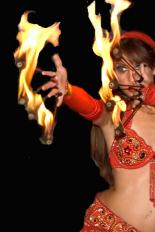Playing with Fire
Below you will find information on fire acts used in Belly Dance.
People have been playing with fire for centuries. It has been a prominent part of ancient rituals and has always held a certain fascination in the human mind. Fire has been used for entertainment purposes around the world in a variety of ways and has often been incorporated in certain types of dances. Traditional dances in the Middle East such as Shamadan or Seneeya utilize candles and balancing. Dances in other parts of the world also feature fire such as the Indian Charkula or even Fire Poi which has origins in New Zealand's Maori people. Besides dancing, entertainers around the world have been swallowing, breathing, and holding fire to the delight of their audiences for centuries.
Fire swallowers and jugglers have been common side show acts in circuses and carnivals since the 1700s. Traveling performance troupes featuring such acts were common from the Medieval world all the way back to the ancient world. In modern times the art of bellydancing has been fused with many other styles of dance and has grown to incorporate a number of different props. Bellydancers who work with these different fire props and acts in other performance styles have continued to fuse and develop new props and tricks. Among the more common types of fire dancing props in Bellydance are fire swords, fire fans, fire fingers, palm torches, fire belts, and poi.
Fire swords can be incorporated into the familiar scimitar routine and involve dipping the tip in a flammable substance and lighting it on fire. The sword tip is far enough from a dancers head that she can perform most of the usual sword dancing tricks while the sword is lit. Fans and fingers add a new and exciting element to fan dances which are themselves newer fusion styles of Bellydance. Palm torches can be used much like candles in the palm of the hand. Fire belts attach around the hips with torches extending outwards. Poi involves a lit wick that is swung around the body by quick rotations of the wrist. Poi was one of the first types of fire dancing to be incorporated into Bellydance and remains one of the most popular among fire dancers. Fire dancing first became popular among tribal and fusion style Bellydancers but has been growing in the Cabaret/Nightclub community as well. There are over 20 different commonly used fire dancing props many of which have already been incorporated into fire acts by bellydancers.
When done well Bellydancing with fire can be mesmerizing and beautiful but it can also be very dangerous. Fire dancers tend to wear costumes made of leather, treated cotton, or metal because they are more fire retardant. They tend to stay away from excessively flowing costumes with lots of fringe or fabric and tend to favor more body hugging costuming and coins. The coins although not highly flammable can get very hot and can burn the skin. Synthetic materials which are most common in cabaret costuming can melt, burning and even sticking to the burnt skin. Making sure that you plan costumes that will be safe for your performance is essential. In addition to costume issues dancers often keep their hair pulled back and/or up to keep it controlled and away from the fire. Depending on the fire prop used it may or may not get close enough to the hair or costume to make this an issue.
For safety concerns it's best to avoid wearing highly flammable things like hair spray or certain types of body gels. It's also a good idea (and in most places probably required for fire safety codes) to have a bucket of water, a wet towel, a spray bottle with water, and ideally a dry chemical fire extinguisher with a spotter. Most performers must acquire a licence in order to perform fire acts publicly and they usually have to carry fire insurance. If your interested in learning and performing these acts you should make sure to check what your local state or country laws require. There are also other other health concerns for people who perform fire acts because of the chemicals they expose themselves to. Isoparaffin oil, Paraffin oil (kerosene), White gas (naphtha), Lamp oil, Biodiesel, Methanol, Ethanol, and Isopropyl are among the usual fuels used by performers and some have the possibility of being quite toxic to the performer.
If your set on learning and performing you should make sure to practice, practice, practice. Practice is generally done mostly without the fire until you have performed it so many times that you can pretty much do it without thinking and with no mistakes. Mistakes with fire equal injury or worse. Always put safety first and keep your safety gear (extinguishers, bandaids, burn cream, etc...) close by. Many fire dancers learn on their own through reading, trying, and even some instructional DVDs but if you can find someone to teach you it will make learning much better. They will be able to share tips and experience with you and give personal feedback to help you with your specific problem areas. The availability of fire performers is not consistent in all locations. Those who combine Bellydance with fire dance are concentrated largely around the San Fransico Bay area in California. However, even if you can't find a Bellydance who does fire tricks you can still seek out someone who only does fire dancing (fire perfomance, fire tricks, etc...) who can still teach you the basics of using the fire props (sometimes called "fire toys").
To see a few of the types of fire props in use see the videos below.

